|
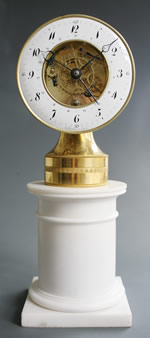
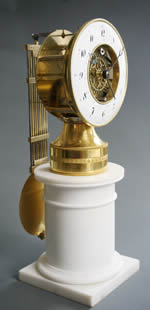
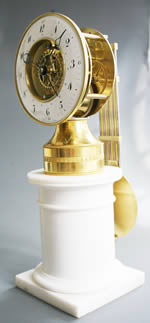
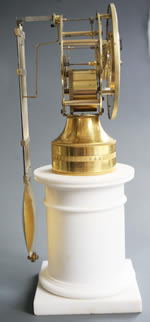
(Click
image to enlarge)
|
A RARE SQUELETTE TABLE TIMEPIECE
VANDERSTEEN À PARIS. CIRCA 1815.
The timepiece is supported on a plain bell shaped piece on an
ormolu cylinder with a small central band of anthemion leaves
and a beaded upper edge. This is again supported on a circular
white marble column on a square plain plinth.
The dial consists of a white enamel chapter ring with Arabic
hour chapters and fifteen minute numerals and a concentric inner
date ring numbered for the even days and with marks for the
odd days. The lower edge is signed " Vandersteen à
Paris" The open dial centre reveals the fine wheelwork
of the motionwork and the hands are of blued steel.
The 28 day movement has a recoil escapement and a gridiron pendulum
with a lenticular bob which is suspended on a knife edge.
Vandersteen.
Paris. Rue de l'Echiquier. 1815-1820.
Height: 14.5 ins. (37 cms.)
Width: 5.5ins.(14 cms.)
Depth: 5.5 ins (14 cms.)
Price:
£SOLD
Ref:
U03
..........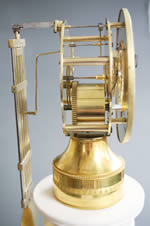 ............ ............
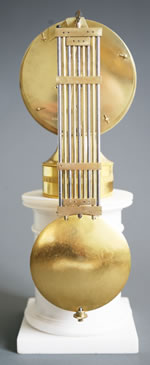 .....
.....
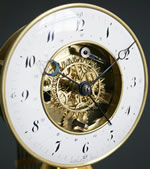 ...
....... ...
.......
....
(Click
image to enlarge)
|
|
|
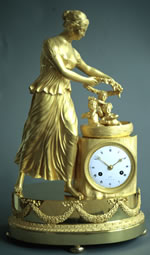
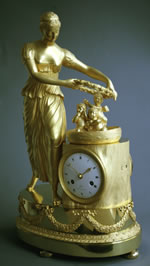
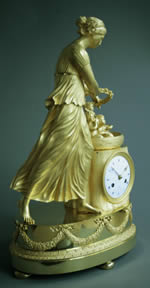
(Click
image to enlarge)
|
A
FINE ORMOLU FIGURAL MANTEL CLOCK.
Galle. Rue Vivienne à Paris. Circa 1805
"Amarettos in a Nest"
A young woman with dress and hair "à la Grecque"
holds a wreath of roses over a nest shaped basket containing
three Amarettos, resting on a tree trunk into which the clock
dial and movement is inserted. The oval base , decorated with
foliate swags and a floral pattern banding , stands on four
bun feet.
The white enamel dial with Roman hour chapters , is signed ,
"Galle. Rue Vivienne à Paris", and the matching
hands are of pierced gilt brass
The eight day movement has a silk suspended pendulum and strikes
the hour and half hour on a bell.
Claude
Galle (1759 - 1815) was one of the most famous bronziers
from his time, became master in 1786 and moved with his workshop
in 1805 to Rue Vivienne .
Illustrated : No. 216 page 132 in French Bronze Clocks by Elke
Niehüser.
Price:
£SOLD
Ref:SR7
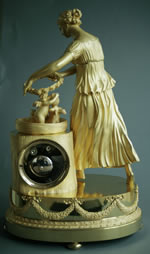 ........ ........
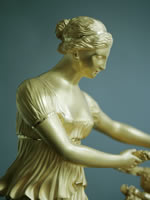 .. ..
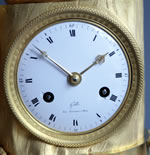 ......... .........
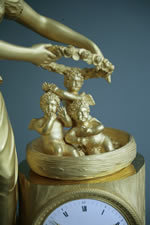
(Click
image to enlarge)
|
|
|
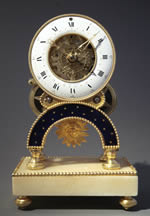
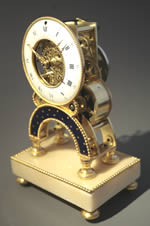
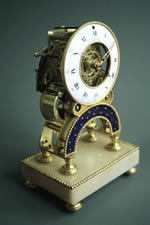
(Click
image to enlarge)
|
A
SMALL DIRECTOIRE " SQUELETTE" .
Orange à Versailles Circa 1795
A
late 18th century marble , ormolu and enamel skeleton clock
signed Orange à Versailles..
The dial and movement, is supported on two parallel arches which
rest on two pairs of turned ormolu supports on an off-white
marble base with a beaded top edge and standing on four ormolu
feet. The front arch is decorated with a deep blue fired enamel
with gilt stars and bordered with ormolu beading which also
borders the chapter ring and winding arbors.
The white chapter ring has Roman hour numerals and Arabic five
minute markers, an inner concentric 31 day calendar ring with
red numerals, and is Signed "Orange à Versailles".The
gilt hands are pierced and the open spade calendar hand is of
blued steel.
Through the center of the chapter ring , can be viewed the eight
day striking square shouldered movement with a fully skeletonised
front and back plate revealing all of the wheelwork. The sunburst
pendulum is silk suspended. Both ends of the spring barrels
are also skeletonised.
Height:
9.8 ins. (25 cms.)
Width: 6.3 ins. (16 cms.)
Depth: 4.3 ins. (11 cms.)
Price:
£SOLD
Ref:SR6
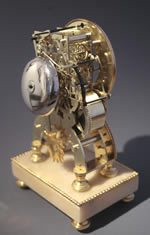 ........ ........ ....... .......
 .
.. .
..
(Click
image to enlarge)
|
|
|
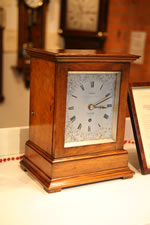
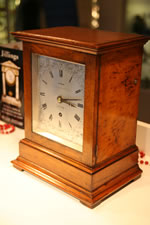
(Click
image to enlarge)
|
A
SMALL OAK LONDON BRACKET CLOCK WITH PASSING STRIKE by Joseph
Fairer,
17, Bishopsgate Without. LONDON
No.990 Circa 1852
The
oak case, made of finely selected burr and grained timber has
a flat top with a cornice moulding and stands on a rectangular
base with a plinth moulding on four pad feet. The front glazed
door with an integral silvered reflector ring reveals the silvered
and engraved rectangular dial which is signed to the centre
, "FAIRER 17, Bishopsgate Without, LONDON. 990". There
are Roman hour numerals and the space outside the minute track
is filled with fine foliate and floral engraving. The hands
are of steel.
The rear glazed door reveals the 8 day fusee movement with rectangular
plates and and a rear mounted bell for the passing strike on
the hour. The brass pendulum has a lenticular bob and a holdfast
for transportation.
Height :11 ins. ( 28 cms.)
Width : 8¾ ins. ( 22.2 cms.)
Depth: 6¼ ins. ( 15.9 cms.)
Joseph
Fairer is listed in Brittens as making at 17, Bishopsgate Without
. London 1851-1853.
Price:
£SOLD
Ref:
T43
........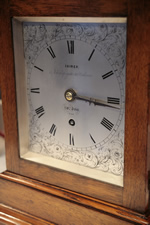 .............. ..............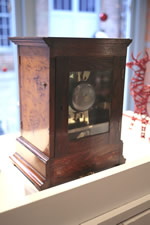
(Click
image to enlarge)
|
| |
|
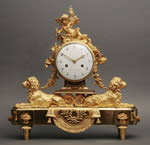
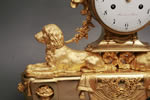
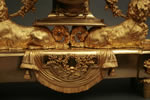
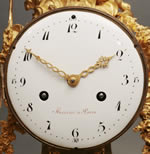
(Click
image to enlarge)
|
A
RARE LOUIS XVIth ORMOLU MANTEL CLOCK.
Mercier. Paris. CIRCA 1785
The fire gilded case depicts two spaniels supporting the main
clock movement and dial which is surmounted by Cupid amongst
clouds and carrying a flaming torch.
The high quality casting is superbly finished with burnished
highlights enhancing the detail.
The white enamel dial has Arabic hour numerals and is signed
Mercier a Paris.
The pierced interlaced hands are of gilded brass.
The eight day movement countwheel strikes on a bell, and the
pendulum is silk suspended .
Price:SOLD
Ref:SR5
|
| |
|
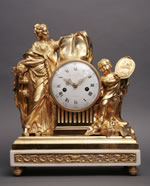
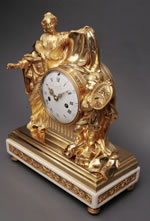
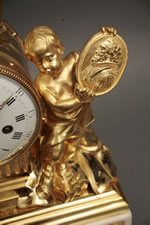
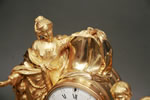
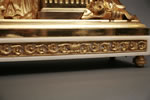
(Click
image to enlarge)
|
A
LOUIS XVIth ORMOLU AND WHITE MARBLE FIGURAL MANTEL CLOCK.
Le Nepveu à Paris. Circa 1785
The clock, supported by a reeded column, is flanked by fire
gilded bronze sculptures of " la Renommée"
and a child holding a medallion of Henry IVth.
The white marble base with an inset pierced foliate gilt bronze
frieze stands on four turned feet. And above this there is a
stepped ormolu plinth.
The white enamel dial has Roman hour chapters and Arabic five
minute numerals with small gilt markers. The dial is signed
, "Le Nepveu A PARIS " in red script. The rear of
the dial is signed by the enameller , (Merlet").
The eight day movement with flat bottom plates has a star countwheel
and strikes on a bell. The Brocot escapement and suspension
are a nineteenth Century conversion.
Height: 14 ins. (39.4 cms.)
Width: 11.4 ins.(29 cms.)
Depth: 5.5 ins (14 cms.)
LE NEPVEU Nicolas-Antoine. (b. 1736; d Paris 24 April 1796).
Ouvrier libbre (1767);Received as master on 8 January 1773by
Trinity Hospital privelege.Established Rue de Salkle au Compte
(1773), Rue Magloire (1796).Used clock cases by J.B Caron l'Ainé,
E.C. Vauchery, N. Bonnet, Leduc and F. Rémond. He had
gilding done by J.L. Cannet and dials made by Barbezat.
Museum: Paris, musée Nissim de Camondo.
Price:P.O.A.
Ref:T48
...........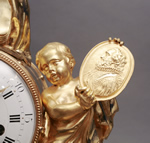 ........... ...........
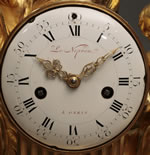
|
| |
|
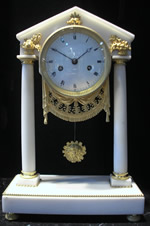
(Click
image to enlarge)
|
A
WHITE MARBLE AND GILT BRONZE PORTICO MANTEL TIMEPIECE . CIRCA
1800
The white marble case on a rectangular base with gilt mounts
has two turned pillars supporting an architectural pediment
with gilt foliate mounts and central mask above the drum and
with a tasseled apron below.
The white enamel dial behind a convex glass with hinged bezel,
has Roman numerals with Arabic fifteen minute markers and blued
steel Breguet hands.
The eight day movement countwheel strikes on a bell and the
pendulum with sunburst bob is silk suspended.
Height: 14½ins. (36.8cms.)
Width : 9½ins. (24.1cms.)
Depth: 4 ins. (10.2cms.)
Price:SOLD
Ref:T34
|
| |
|
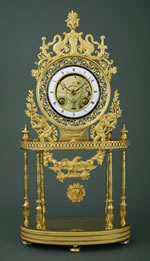
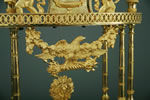
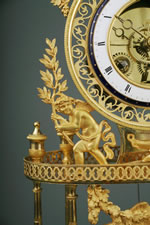
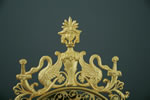
(Click
image to enlarge)
|
AN
ORMOLU " PENDULE SQUELETTE"
OGER À PARIS . CIRCA 1810.
The clock is held behind a fretted and matted frame , and surmounted
by a pair of swans feeding from cornucopiae and with a central
urn topped with a mask with anthemion headress.
Immediately below the clock , two putti flanking a relief casting
of an urn, stand within a gallery holding olive branches . Below
this is an apron consisting of an eagle with thunderbolt (representing
Zeus), suspended from oak tree branches. The whole is supported
on six turned and ringed baluster pillars on an oval base with
a fine milled edge casting.
The Roman dial consists of a white enamel chapter ring, signed
"Oger à Paris" with a blue outer edge decorated
with gold stars. The open dial center reveals the motionwork
of the clock and the pierced hands are gilt.
The eight day movement stikes on a bell and the sunburst pendulum
is silk suspended.
Height:
18.5 ins (47cms.)
Width :9ins. (22.9cms.)
Depth:4 ins. (10.16cms.)
Price:P.O.A.
Ref:T32
-----------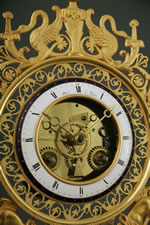 ---------
--------- 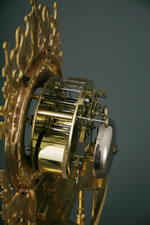
|
| |
|
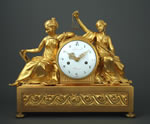
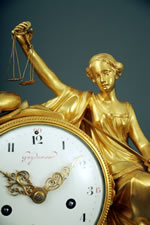
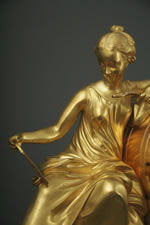
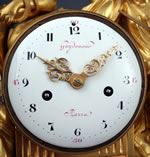
(Click
image to enlarge)
|
A
"TRANSITIONAL PERIOD" ORMOLU
MANTEL CLOCK.
Guydamour à Paris . Circa 1770
The
ormolu case (designed by Antoine Foullet and executed by Augustin
Pajou), standing on toupee feet, has a rectangular base with
a high relief guilloché design with laurel leaves .
The clock movement and dial is enclosed within an ormolu drum
which is supported centrally on a pedestal with a reeded front
and flanking this are two classical female seated figures representing
Justice and Wisdom.
Justice , on the right hand side , holds a sword in her left
hand and balance scales in her other hand.
Wisdom , on the left side, holds a snake in her left hand (representing
wisdom ) and she is looking into a mirror (representing self-reflection
) in her right hand .
The white enamel dial has Arabic hour chapters and red fifteen
minute Arabic numerals and it is signed in red, "Guydamour
,
Paris.". The finely chased and pierced hands are of gilt
brass.
The movement has countwheel striking on a bell and the pendulum
is silk suspended.
A beautifully proportioned neo-classical clock of extreme quality.
Height: 14 ins. (38.75cms.)
Width : 16½ins. (25.4cms.)
Depth: 4¾ ins. (12.7cms.)
Price:SOLD
Ref:
T31
Edme-Philibert
Guydamour
(b. Paris 28 Sepember 1752; d. Paris 17 January 1798). Son of
Edme, wine merchant., and Marie Godart. Nephew by marriage of
Balthazar Lieutaud, master cabinet maker. Apprenticed to L.N.
Delaunay (17660 AND j.f. CALON (1772).Ouvrier libre.Received
as master on 14 august 1784. Established Rue Saint-Denis. Guydamour
produced high quality clocks , using cases by the Osmonds and
F Rémond.
Museums: Spain, Patrimonio Nacional; New York, Metropolitan
Museum ; Pavlosk, chateau; Saint petersburg, Hermitage; San
Marino (Calif.) Huntington Collection.
Antoine Foullet was a great specialist of the clock case
production. He was an independent cabinet-maker and became a
master quite late in his career, when he reached 40.
When he died in 1775, the inventory of his possessions details
a very productive workshop with six fully tooled benches and
an important stock of clock cases.
Antoine Foullet designed and produced very high quality bronze
clock cases, although the corporation rules forbade that practice.
It is interesting to note that this rule did not influence him
much, as he left a large number of clock cases in his inheritance
to his son Pierre-Antoine. The Foullets father and son were
great masters of the"rococo" style, and surpassed
themselves in the neo-classicial style, to which our clock belongs.
Some of the best public and private collections in the world
exhibit their artwork.
Augustin
Pajou 1730-1809 ) was an exceptionally talented sculptor:
as a pupil of his father, also a sculptor, he grew up in the
Faubourg Saint-Antoine. As his talent was noticed at an early
age, he became also a pupil of Jean-Baptiste Lemoyne
After 4 years in Lemoyne's workshop and aged only 18, he won
first prize of theRoyal Academy of Scupture. Winning the Rome
award, he was taken under the protective wing of Louis XV who
financed further studies at the French Academy in Rome, then
under the directorship of the painter Nicolas Vleughels.
Some of his creations can be found in the best monuments in
and around Paris, such as the Royal Palace or the Opera Room
in Versailles.
|
| |
|
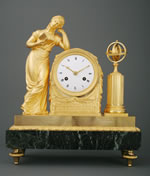
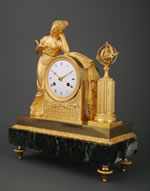
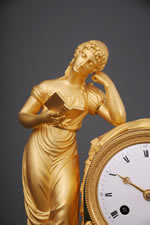

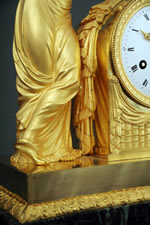
(Click
image to enlarge)
|
AN
EMPIRE ORMOLU AND GREEN MARBLE MANTEL CLOCK . "ASTRONOMY".
CIRCA 1810.
The clock represents "Astronomy", after a design by
Jean-Andre Reiche (1809). The case consists of a "borne"
shape simulating a library and containing the clock dial and
movement, flanked by a woman leaning on her elbow and reading
and on the other side an armillary sphere on a reeded column.
The base is made of "vert de mer" marble and stands
on toupee feet.
The white enamel dial has Roman numerals , and the gilt hands
are well chased.. The eight day movement countwheel strikes
on a bell and the pendulum is silk suspended.
Height: 13.4ins. (34cms.)
Width : 11.8ins. (30cms.)
Depth: 4.7 ins. (12cms.)
Price:SOLD
Ref:T10
------------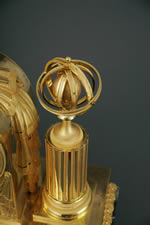 --------- ---------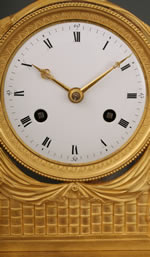
|
| |
|
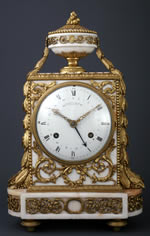 ] ]
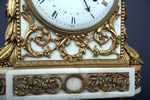
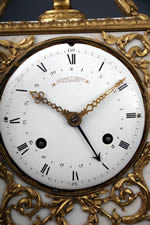
(Click image
to enlarge)
|
A LOUIS XVI GILT BRONZE
MOUNTED WHITE MARBLE STRIKING MANTEL CLOCK WITH CALENDAR. By
"GASTON JOLLY a PARIS."
CIRCA 1790.
The marble case densely covered with ormolu scroll mounts
has an urn finial trailing berried laurel mounts to the sides,
break arched sides to the base, and stands on toupee feet.
The white enamel Roman convex dial with Arabic quarters and
inner concentric calendar ring, is signed within a banner
to the centre, " GASTON JOLLY a PARIS". The gilt
hands are of pierced criss-cross design and the calendar hand
is a blued steel arrow. The twin barrel movement with flat
bottom plares countwheel strikes on a bell , has a verge escapement
and silk suspended pendulum.
Francois- Pierre Jolly called
Gaston Jolly, was received as master on 6th May 1784. Established
Rue des Arcis (1784). Rue Michel le Compte, subsequently renamed
Rue Michel le Pelletier. Used clock cases by the Osmonds.
Height: 15.25ins. (38.75cms.)
Width : 10ins. (25.4cms.)
Depth: 5 ins. (12.7cms.)
Price: P.O.A
Ref: TXX
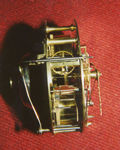
|
| |
|
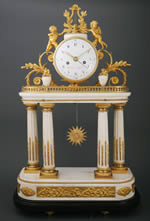
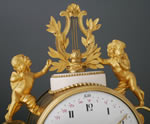
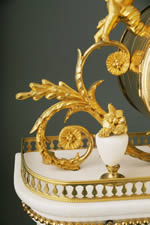
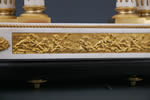
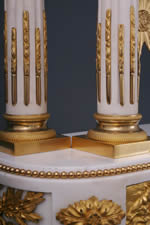
(Click
image to enlarge)
|
AN
IMPRESSIVE LOUIS XVIth MARBLE AND ORMOLU PORTICO CLOCK
Piolaine à Paris. Circa 1785
This
impressive portico clock stands on toupee feet on a black marble
plinth and has a white marble base with rounded front corners
with applied ormolu mounts and and a centrally inset relief
cast panel showing putti at play . Two further inset foliate
mounts are inset in the sides.
The clock movement and dial within a gilded drum, and on a scrolled
foliate cast support attached to a galleried and beaded white
marble platform , is supported on four fluted white marble columns
with ormolu bases and capitals.
Flanking the clock dial, are two white marble urns with ormolu
foliate tops, and surmounting the clock is an ormolu lyre with
marble plinth flanked by two Putti.
The white enamel dial is signed" Piolaine à Paris
and there are Arabic hour numerals and fifteen minute markers.
There is also an additional calendar ring. The pierced and chased
minute and hour hand are of a criss-cross design with fleur
de Lys tips , and the calendar hand is of blued steel with an
arrow tip.
The eight day movement countwheel strikes on a bell and has
a silk suspended pendulum with a large sunburst bob.
Michel-Francois
Piolaine M. 1787. Rue des Ecrivains, 1789. Rue des Gravilliers,
de l'an VII à 1810.
Height:29 ins. (73.7cms.)
Width : 18ins. (45.7 cms.)
Depth: 8 ins. (20.3cms.)
Price:SOLD
Ref:MSR2
--------------- 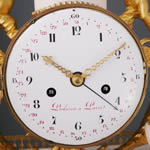
|
| |
|
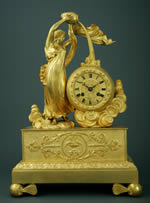
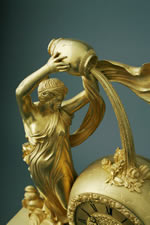
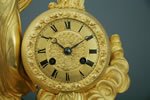
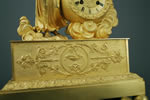
(Click
image to enlarge)
|
A
FRENCH RESTAURATION ORMOLU MANTEL CLOCK.
Douyon CIRCA 1824
This
fine sculptural ormolu clock has a rectangular base which stands
on four ball feet, the front two with butterfly wings and the
back two with fine engine turning.
The clock movement and dial is contained within a representation
of the earth into which Tethys (the goddess of freshwater ,
rivers and clouds) is pouring the life giving water from her
pitcher, causing the visible growth of the plants. The goddess
is standing amongst the clouds with her drapery flowing in the
wind.
The base has an inset frieze with two doves drinking from an
urn framed by a ring and surrounded with further floral and
foliate decoration . Below this there is an anthemion moulding
on the lower plinth.
Height:
17½ins. (44.5cms.)
Width : 12¼ins. (31.1cms.)
Depth: 5 ins. (12.7cms.)
Price:SOLD
Ref:
S62
|
| |
|
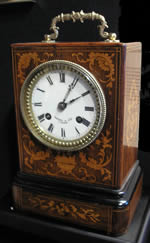
(Click
image to enlarge)
|
A
MARQUETRY "CAMPAIGN" CLOCK CIRCA 1840.
The rectangular case of rosewood with foliate and floral marquetry
and with fine boxwood stringing, has a small glazedaperture
in the flat top. The clock is surmounted by a decorative fire
gilded handle
The circular white enamel dial , behind a hinged decorative
beaded bezel with bevell edged glass has Roman hour numerals,
steel pierced hands and is signed Henry & Cie. À
PARIS. The movement is of eight day duration , countwheel strikes
on a bell and has a silk suspended pendulum. The backlate is
also stamped "Henry & Cie, à Paris.
Height:
9.5 ins.
Depth: 4.5. ins.
Price:
£SOLD
Ref
: S22
|
| |
|
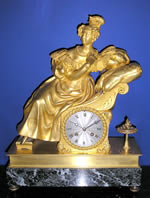
(Click
image to enlarge)
|
AN
ORMOLU AND MARBLE FIGURAL MANTEL CLOCK. Barrard & Vignon.
Paris Circa 1860
The fine gilded bronze figure of Marie Antoinette reclines on
a scroll baccked chair and tasselled cushion on a Vert de Mer
marble base on toupee feet.
The
clock is held within the base of the chair and has an engine
turned silvered dial with Roman numerals and blued steel Breguet
hands . The movement countwheel strikes on a bell and the backplate
is stamped with the makers name and address. The pendulum is
silk suspended.
Barrard
& Vignon . Rue Commines. 7. Paris 1860-1870
Height:
13ins.
Width: 7.5 ins.
Depth: 4 ins.
Price:
£SOLD
Ref:
R95
|
| |
|
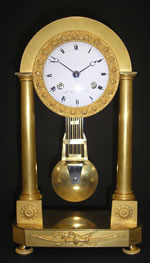
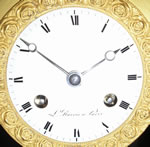
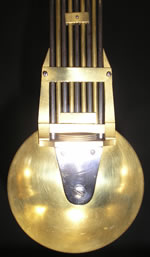
(Click
image to enlarge)
|
A
SMALL ORMOLU PORTICO MANTEL CLOCK.
LENOIR RAVRIO À PARIS. CIRCA 1830
The clock with an arched top is supported between two columns
on cube bases with applied floral paterae. The base has angled
front corners and has a bow and quiver motif to the front.
The compensated pendulum with a large lenticular bob hangs on
a steel suspension from the eight day movement which countwheel
stikes on a bell.
The white enamel dial surrounded by a decorative floral bezel,
has Roman numerals , blued steel Breguet pattern hands and is
signed " L. Ravrio. Paris."
Lenoir
Ravrio. Paris. Rue des Filles St. Thomas. 1820-1840
Height: 13ins. (32.5cms.)
Width : 7.5ins. (19cms.)
Depth: 4 ins. (10.1cms.)
Price:
£SOLD
Ref:
Q06
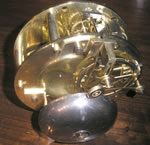 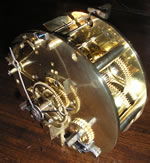
|
| |
|
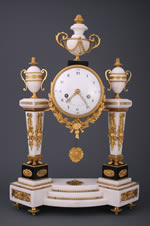
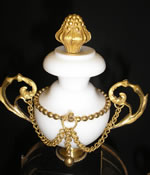
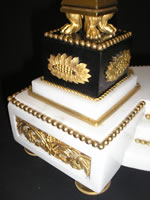
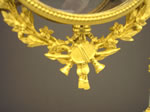
(Click
image to enlarge)
|
A
LOUIS XVIth BLACK AND WHITE
MARBLE PORTICO CLOCK WITH ORMOLU MOUNTS..
GAVELLE À PARIS CIRCA 1780
The
drum case with an ormolu wreath below is surmounted by an urn,
supported by two pedestal shaped ormolu mounted columns topped
by urns. The shaped stepped base with foliate mounts is raised
on turned feet
The white enamel dial with Arabic numerals signed Gavelle L.e
A Paris and has pierced and engraved fleur-de-lis hands.
The similarly signed flat bottomed countwheel bell striking
anchor movement has a silk suspended sunburst pendulum,
Gavelle.
Pierre, called l'Ainé. (born Paris 1753. died Paris 14
December 1802). Son of Jean-Jacques and Marie-Madeleine Grimperel..
Married to Marie-Jeanne Leclair. Received as Master on 4th September
1771. Député (1785). Worked with his father until
1787, then set up a separate establishment in the Rue Saint
denis (1787) and the Rue des Juifs (1801).
Museums: Chaalis, musée Jacquemart-André,; Pavlosvsk,
château.
Height:
20½ins. (52cms.)
Width : 14ins. (35.5cms.)
Depth: 5 ins. (12.7cms.)
Price:
£SOLD
Ref:
Q10
--------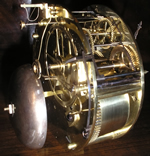 -------- --------
--------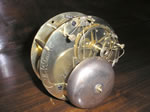 ----------- -----------
|
| |
|